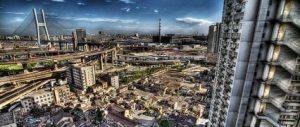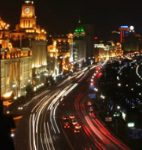The “Asian Tigers” of the past, now grappling with shambolic infrastructure, are watching with envy and despair as mighty China builds the most advanced integrated-transportation network on earth. Tens of thousands of high-speed rail tracks (already the longest system in the world of its kind and growing), futuristic airports, immense motorway networks and environmentally sound mass-transit systems will soon serve all of the nation’s major cities.
For decades, Indonesia, Thailand, the Philippines and Malaysia – staunch allies of the west and enthusiastic consumers of all types of pro-market dogma – used all means of propaganda and intimidation to discredit socialist (and god-forbid Communist) central planning. To loud cheers from western media, they privatised everything from natural resources to public parks, allowing the automobile lobby to turn their cities into polluted urban sprawls, dotted with office buildings, malls and chain eateries, but severely lacking in parks, public spaces and cultural institutions. Old tram lines were paved over, rail tracks abandoned and sidewalks swallowed by developers.
To those willing to see the reality, it is evident such systems have failed. None of the “free market” south-east Asian countries, with the exception of Singapore (in which transport is planned and controlled by the state) has managed to construct decent cities for its citizens. Rather, as the Australian artist George Burchett said after visiting Jakarta: “The cities were built against the people.”
Despite many faults – unavoidable in a country of its size – China’s socialist model for planning and building inter-city and urban transportation systems could and should inspire the rest of Asia and the world, including much richer countries like Japan and the United States.
In August and September, 2010, I joined one of my best friends, the Chinese concert pianist Yuan Sheng, on a 4,500 kilometre-long journey through his country. Following one of his brilliant concerts at the Forbidden City Concert Hall in Beijing, we hit the road, travelling from the capital all the way to Huangshan. We drove his car, rode maglev and bullet trains, took cable cars, sailed on tiny riverboats and hiked over mountains.
Chinese culture and its current system never cease to impress me, and this journey was no exception. What astonished me most this time, however, was the scale and coherence of government efforts to build a giant, but also green, transport system, designed to move more than a billion people and billions of tonnes of goods. While many of the developing countries abandoned to market forces – Peru, Kenya, Indonesia – have experienced neglect, even determined obstruction, of public transportation, countries using socialist planning (in some cases with the participation of private companies) have registered tremendous progress. These countries include both Chile and China.
What could be more environmentally-friendly for an enormous city than wide sidewalks, modern and fast metro systems and buses that run on liquid natural gas? Now Beijing has it all. Eight subway lines, 220 kilometres of tracks and 147 operating stations move over 4 million passengers every day in relative comfort and at a fraction of the cost of equivalent cities – it is just two yuan (US$0.3) per ride. Tens of thousands of buses and trolleybuses cover the entire city almost free of charge: 0.40 yuan (US$0.06) per journey in a city with a higher per-capita income than many south-east Asian capitals charging five to 10 times more for a similar service.
And Beijing is still building. New subway stations are joining the network at such speed that map-printers can hardly keep pace. By 2012, the length of the capital’s metro network will reach reach 420 kilometres. The capital is not the only city in the country to boast its underground rail system: eleven other Chinese cities already have operating subways and 20 more are ready to begin construction. Combined, they will give China, without any competition, the world’s largest mass-transit network. China is also experimenting with new and green modes of transport, including the mooted “super bus” – a catamaran-shaped street vehicle that straddles cars and is predicted to reduce traffic jams by 20% or even 30% in the most congested neighborhoods, though roll-out has been postponed.
For comparison, let us visit some countries in south-east Asia that, until recently, enjoyed a level of development equivalent to or higher than China.
Architect Hari Sungkari, who is secretary general of the Indonesian Society for Creative Industry and member of the Indonesian Railway Network Association, explains his country’s predicament: “During the Dutch colonial rule, around 12,000 kilometres of tracks were built across the Indonesian archipelago. In 1980, only 6,000 kilometres were functional. By 2000, that number had shrunk to 4,000 kilometres. The problem in this country is that the private sector and even the state insist on making transportation profitable, while in many other countries (including China) transportation is a service, not a money-making venture.”
Heading for what is expected to be “total gridlock” by 2012, staunchly capitalist Jakarta, with its 13 million inhabitants, lacks sidewalks, public parks and any acceptable mode of public transport. Its few outdated trains are overcrowded and dangerous – people often ride on top and all too frequently fall through rotten roofs to their deaths. So-called “bus-ways” are usually locally made vehicles equipped with only one door. A monorail project was scrapped in 2008 – but only after it had scarred the streets with metal and concrete pillars pointing towards the sky; another victim of endemic corruption.
Significantly richer Thailand is not faring much better. Of course the country counts some of the best freeways in Asia (thanks to a powerful car lobby and manufacturers who gave Thailand the nickname “Detroit of south-east Asia”) but its dirty and hopelessly slow rail system is collapsing. No city outside of Bangkok has public transport and even the major urban centres of Chiang Mai and Hat Yai are fully reliant on private cars and scooters.
Even Malaysia, which aims to reach “first world status” in the near future, offers few options for moving around in comfort and safety outside of Kuala Lumpur. And the citizens of Kuala Lumpur too are vocal in their criticism of the city’s fragmented transit systems. Still, the Malaysian state, with at least some central planning and a determination to improve the life of ordinary citizens, has the second best public transportation system in south-east Asia (right after tiny and efficient Singapore). But it is in no sense a match for China.
Asked why China is so successful in providing public services for its citizens, while south-east Asia appears to serve only business and elite interests, professor Dadang M Maksoem, a former lecturer at Malaysian universities who now works for the government of West Java, in Indonesia, gets furious: “Very simple: they [China] have commitment to do the best for their nation, which we don’t have here anymore. How come, in this part of the world, governments can’t even provide decent public transportation? People are forced to buy their own motorcycles so they can transport themselves – having to risk their lives, having terrible accidents. Now there are traffic gridlocks everywhere. You can say that our system is stupid, idiotic, brain-dead, greedy. Just go on and fill the gap!”
Needless to say, in most Chinese cities scooters (or what they call “motorbikes” in south-east Asia) are banned, while well-paved bicycle-lanes are found even in small towns. There are hardly any bicycle lanes in south-east Asia, again with the exception of Singapore.
Beijing and Shanghai may be suffering from traffic jams due to the dramatic increase in private car ownership (a result of surging living standards) but China and its leaders are facing the difficulties head on, spending enormous sums of money to find and implement innovative and green solutions to transport and pollution problems. Prices are kept low to encourage people to take trains or other eco-friendly alternatives, rather than get into cars and onto highways. For instance, a second class ticket for the high-speed train between Beijing and Tianjin, which covers the distance of 117 kilometres in less than 30 minutes, costs around 53 yuan (US$8). To travel roughly the same distance on a marginally slower Japanese bullet train between Nagoya and Kyoto would be eight times more expensive.
While intra and inter-city trains are attracting passengers with low prices and efficiency, China’s enormous expressway network known as the National Trunk Highway System (NTHS) is doing all it can to discourage private cars from its sleek surfaces. Tolls are very high – the driver of a private sedan would have to spend over US$100 for a one-way journey between Beijing and Shanghai. During our trip, especially at night, our car – surrounded by trucks and long-distance buses – was often one of very few private vehicles travelling on the intercity highways.
As China constructs platforms, tracks bridges and tunnels at breakneck speed, south-east Asia (part of the world which until recently was similar to China in terms of income-levels and Human Development Index ranking) is choking in smog from dirty car and scooter engines. The region’s cities were long ago abandoned to private business interests and are gradually turning to enormous, California-style suburbs, though with dramatically lower incomes.
The west discouraged socialist central planning for decades in almost all corners of Asia. But it is this very model that is now saving the continent – and therefore the world. Were China to follow the example of the Philippines or Indonesia, it would lead to complete environmental collapse. As it is now, there is no doubt that the legendary Chinese dragon is still red and is flying much higher and much faster than anyone else in his neighborhood.
Andre Vltchek is a novelist, filmmaker, journalist and photographer based in east Africa and Asia. His latest book, about neo-colonialism in the South Pacific, is called Oceania.
Homepage image by Andre Vltchek shows the new Chinese bullet train


